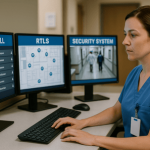
Pop-Up Hospitals Aren’t Out of the Woods Yet When It Comes To Unique Security Vulnerabilities
Here’s how the innovative application of security tech solutions can help.
Temporary hospitals have popped up across the U.S. in an effort to address patient overflow in medical facilities due to the COVID-19 pandemic and they’re not on their way out yet. Some states are considering them a viable option as surges of COVID-19 continue to sweep across the country. Many of these medical sites include hotels, parks, gymnasiums, and have even included cruise ships! While these temporary locations have increased the capacity to treat patients, a unique array of security challenges have arisen. The implementation and innovative application of security tech solutions can be utilized in these settings to ensure compliance and that these unique security needs are being met.
The Unique Security Vulnerabilities of Temporary Hospitals
Temporary medical settings bring about a suit of vulnerabilities due to their remote nature and lack of major infrastructure. Traditional hospital security systems are constantly being monitored, maintained, and upgraded to meet industry standards. Temporary medical units, however, lack the infrastructure and even attention during times of crisis when it comes to meeting security standards demanded by the medical field. In the case of the COVID-19 pandemic, implementing access control to restricted areas, monitoring the coming and going of patients, medical personnel, and equipment, and establishing secure perimeters are just some of the challenges being faced in these settings.
Implementing Unique Security Vulnerabilities Tech Solutions
Video Surveillance and Motion Detection for Unique Security Vulnerabilities
Basic solutions to alleviate some of these unique challenges can include security technology such as video surveillance cameras or motion detection systems all implemented for monitoring and access control purposes. If a strong hospital perimeter is established, these tools can aid in identifying intruders or unauthorized personnel in the area. Intrusion detection systems comprised of video surveillance and motion sensors can be deployed at various access points around the mobile facility.
Remote Video as a COVID-19 Mitigation Strategy for Unique Security Vulnerabilities
Picture a restricted area designated for patients to quarantine. It could pose major health risks to patients or unauthorized healthcare personnel who come into range of the area or with its occupants. In this instance, the application of analytics-enabled cameras on a fixed position AI unit would serve as a strategy to mitigate the spread of illness. When calibrated to do so, these intelligent systems can enable warnings such as flashing lights and a broadcasted message informing anyone in the area of detection they were in a restricted area and should immediately leave the area. Intelligent video surveillance can also allow you to gauge if individuals are wearing various types of PPE should they need to enter these restricted areas.
Voice-Down Services for Unique Security Vulnerabilities
Many video surveillance systems, particularly could-based solutions, are equipped with one-way video and two-way audio capabilities that can verbally advise individuals to leave a restricted area before they are potentially exposed to a virus. they. These systems have the capacity to stop incidents of dangerous contact before they happen.
Social Distancing/People Counting for Unique Security Vulnerabilities
Another application of video surveillance with motion detection capabilities can be applied to help monitor and enforce social distancing policies enforced within the medical setting. Social distancing measures have limited the maximum number of individuals allowed in hospital facilities at a time - which is part of why pop-up medical facilities have been implemented. A surveillance system calibrated with motion-based alerts can notify hospital security or medical staff when individuals are detected in-frame, so they can easily assess the scene and ensure social distancing protocol compliance.


